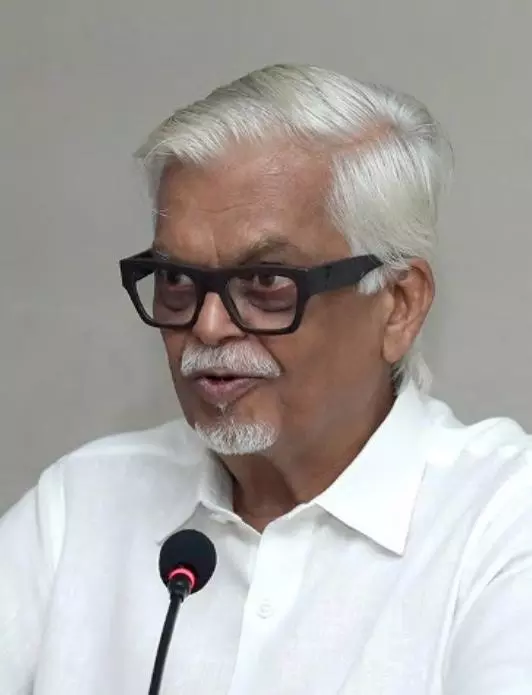Sanjaya Baru | The bond of wealth, power: SC verdict won’t end nexus

The verdict of the Supreme Court on the electoral bonds scheme has been widely welcomed. Even the Bharatiya Janata Party, the scheme’s biggest beneficiary, has also welcomed it. While this verdict may make the scheme more transparent, it is unlikely to end the nexus between wealth and power that defines any democracy.
During the Congress era, the Communists used to refer to the Union government as the “Tata-Birla ki Sarkar”. Today they refer to it as the “Adani-Ambani ki Sarkar”.
Through the electoral bonds scheme, the Narendra Modi government spread its net wide, beyond big business, and garnered more than a lion’s share of the contributions. The late Rakesh Jhunjhunwala, the Big Bull on Dalal Street, once famously told a journalist that his Agrawal community within the bania caste “owned the country”. Look at the names, he said, Jindal, Goyal, Mittal, Bansal, Singhal and so on and on. “So, boss, do we own the country or not?” The dominant section of the business community across the country is invested heavily in Prime Minister Narendra Modi, in his BJP and in Hindutva. So, why would the BJP not corner as much as 90 per cent of the electoral bonds issued in this past half-decade?
The shifts in Indian politics over the past seven decades have, without doubt, shaped the social composition of the political power elite. Their caste, class and regional composition has certainly changed. The rise of the intermediate castes, the OBCs, has been one of the major structural changes in both the class and caste composition of the ruling political class. Yet, the land-owning upper castes have retained their place of prominence and dominance in many regions. From the Jats and Rajputs of North India to the Marathas and Patels of western India and the Reddys, Kammas, Velamas, Chettiars and Nairs of the South, the upper castes have retained their presence in business and politics.
As I have tried to explain in my book, India’s Power Elite: Caste, Class and a Cultural Revolution (Penguin, 2021), in India’s “psephocracy”, as sociologist Ashis Nandy characterised an electoral democracy, wealth remains, above all, the most important determinant of power. The cost of getting people out on election day to cast their vote is rising even as their trust in the system may be waning. Several recent studies have focused on the role of “money power” in politics and the nexus between crime, business and politics. The rising cost of election campaigns, the inability of the State to enforce the rules pertaining to election funding and, more recently, the brazen manner in which political parties in power are able to corner the bulk of the funds provided by corporates and other donors has made politics a game of the rich in which the wealthy become wealthier and are able to become politically more powerful.
It is not, therefore, surprising that a disproportionate number of the members of state legislatures and Parliament are wealthy. There had been some dilution of this aspect in the first decade after Independence with more members of the middle class, including rich peasants, entering politics. However, as election expenses have grown and with the rising importance of political office as a source of both power and wealth, there has been a rise in the number of the wealthy among the elected
representatives of the people.
Consider the social composition of the 17th Lok Sabha, that was elected in 2019. It has more wealthy members than any other Lok Sabha in the past half century. Data collated by the Association for Democratic Rights shows that as many as 475 MPs (constituting 88 per cent of the 539 MPs for whom data was available) have assets upwards of Rs 10 million (Rs 1 crore), slightly up from 443 (82 per cent) in the 16th Lok Sabha. Out of 542 winners analysed during the Lok Sabha 2014 elections, 443 (82 per cent) winners were crorepatis. In the 15th Lok Sabha (2009-14), the comparable number was appreciably less at 315 (58 per cent).
The ADR study shows that not only had MPs become richer during the five years they were members of the Lok Sabha, but that in successive elections since 2009 the proportion of “crorepati” candidates among the victors has also risen. In other words, the wealthy had a better chance of securing admission to political office, and that office became an important source of acquiring wealth. In a country with a nominal per capita income that is less than Rs 200,000 per annum, and at least a fifth of the population living in abject poverty, it is surprising that an overwhelming number of elected representatives, both in the Lok Sabha and in the state Assemblies, are millionaires, if not billionaires.
The ADR data showed that with the exception of MPs from the Communist parties, all other MPs of all other parties were millionaires, with the BJP having the largest number of them. As many as a third of MPs in the 17th Lok Sabha had assets worth more than Rs 50 million, while average assets per winning MP was Rs 21 million. The wealthiest MPs, however, came from smaller political parties like the YSR Congress, Nationalist Congress Party, DMK, Bharat Rashtra Samiti (BRS) and the Akali Dal.
These are, of course, declared assets, and that too, in the name of the specified individual and not of all family members taken together. Many wealthy Indians hold considerable wealth in the name of their spouse. The ADR data also shows, interestingly, that MPs from regional parties like the Akali Dal, BRS and the Nationalist Congress Party saw the highest increase in wealth of sitting MPs between the general elections of 2014 and 2019.
The role of money power in politics has only increased with time and this is reflected in the wealth of elected politicians. With the decline of the Congress, the balance of power and wealth has shifted in favour of the BJP. Hindutva politics has arrived with deep pockets, with the rural and urban rich bankrolling the BJP, making it the richest political party. The electoral bonds scheme was just one more instrument used by a party in power to cement the alliance between wealth and power.

